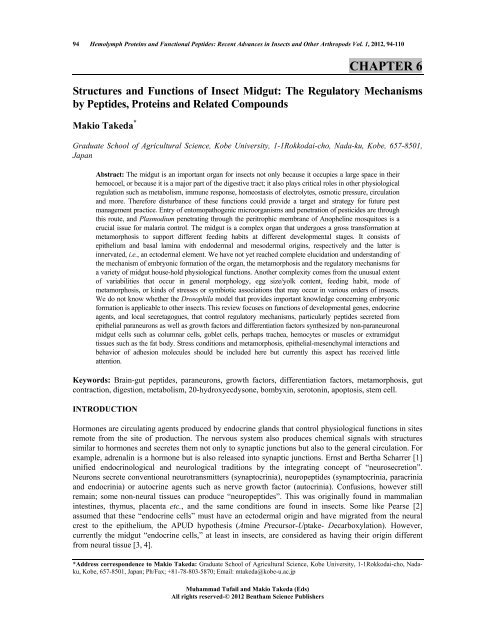chapter 1 - Bentham Science
chapter 1 - Bentham Science
chapter 1 - Bentham Science
You also want an ePaper? Increase the reach of your titles
YUMPU automatically turns print PDFs into web optimized ePapers that Google loves.
94 Hemolymph Proteins and Functional Peptides: Recent Advances in Insects and Other Arthropods Vol. 1, 2012, 94-110<br />
Muhammad Tufail and Makio Takeda (Eds)<br />
All rights reserved-© 2012 <strong>Bentham</strong> <strong>Science</strong> Publishers<br />
CHAPTER 6<br />
Structures and Functions of Insect Midgut: The Regulatory Mechanisms<br />
by Peptides, Proteins and Related Compounds<br />
Makio Takeda *<br />
Graduate School of Agricultural <strong>Science</strong>, Kobe University, 1-1Rokkodai-cho, Nada-ku, Kobe, 657-8501,<br />
Japan<br />
Abstract: The midgut is an important organ for insects not only because it occupies a large space in their<br />
hemocoel, or because it is a major part of the digestive tract; it also plays critical roles in other physiological<br />
regulation such as metabolism, immune response, homeostasis of electrolytes, osmotic pressure, circulation<br />
and more. Therefore disturbance of these functions could provide a target and strategy for future pest<br />
management practice. Entry of entomopathogenic microorganisms and penetration of pesticides are through<br />
this route, and Plasmodium penetrating through the peritrophic membrane of Anopheline mosquitoes is a<br />
crucial issue for malaria control. The midgut is a complex organ that undergoes a gross transformation at<br />
metamorphosis to support different feeding habits at different developmental stages. It consists of<br />
epithelium and basal lamina with endodermal and mesodermal origins, respectively and the latter is<br />
innervated, i.e., an ectodermal element. We have not yet reached complete elucidation and understanding of<br />
the mechanism of embryonic formation of the organ, the metamorphosis and the regulatory mechanisms for<br />
a variety of midgut house-hold physiological functions. Another complexity comes from the unusual extent<br />
of variabilities that occur in general morphology, egg size/yolk content, feeding habit, mode of<br />
metamorphosis, or kinds of stresses or symbiotic associations that may occur in various orders of insects.<br />
We do not know whether the Drosophila model that provides important knowledge concerning embryonic<br />
formation is applicable to other insects. This review focuses on functions of developmental genes, endocrine<br />
agents, and local secretagogues, that control regulatory mechanisms, particularly peptides secreted from<br />
epithelial paraneurons as well as growth factors and differentiation factors synthesized by non-paraneuronal<br />
midgut cells such as columnar cells, goblet cells, perhaps trachea, hemocytes or muscles or extramidgut<br />
tissues such as the fat body. Stress conditions and metamorphosis, epithelial-mesenchymal interactions and<br />
behavior of adhesion molecules should be included here but currently this aspect has received little<br />
attention.<br />
Keywords: Brain-gut peptides, paraneurons, growth factors, differentiation factors, metamorphosis, gut<br />
contraction, digestion, metabolism, 20-hydroxyecdysone, bombyxin, serotonin, apoptosis, stem cell.<br />
INTRODUCTION<br />
Hormones are circulating agents produced by endocrine glands that control physiological functions in sites<br />
remote from the site of production. The nervous system also produces chemical signals with structures<br />
similar to hormones and secretes them not only to synaptic junctions but also to the general circulation. For<br />
example, adrenalin is a hormone but is also released into synaptic junctions. Ernst and Bertha Scharrer [1]<br />
unified endocrinological and neurological traditions by the integrating concept of “neurosecretion”.<br />
Neurons secrete conventional neurotransmitters (synaptocrinia), neuropeptides (synamptocrinia, paracrinia<br />
and endocrinia) or autocrine agents such as nerve growth factor (autocrinia). Confusions, however still<br />
remain; some non-neural tissues can produce “neuropeptides”. This was originally found in mammalian<br />
intestines, thymus, placenta etc., and the same conditions are found in insects. Some like Pearse [2]<br />
assumed that these “endocrine cells” must have an ectodermal origin and have migrated from the neural<br />
crest to the epithelium, the APUD hypothesis (Amine Precursor-Uptake- Decarboxylation). However,<br />
currently the midgut “endocrine cells,” at least in insects, are considered as having their origin different<br />
from neural tissue [3, 4].<br />
*Address correspondence to Makio Takeda: Graduate School of Agricultural <strong>Science</strong>, Kobe University, 1-1Rokkodai-cho, Nadaku,<br />
Kobe, 657-8501, Japan; Ph/Fax; +81-78-803-5870; Email: mtakeda@kobe-u.ac.jp

















